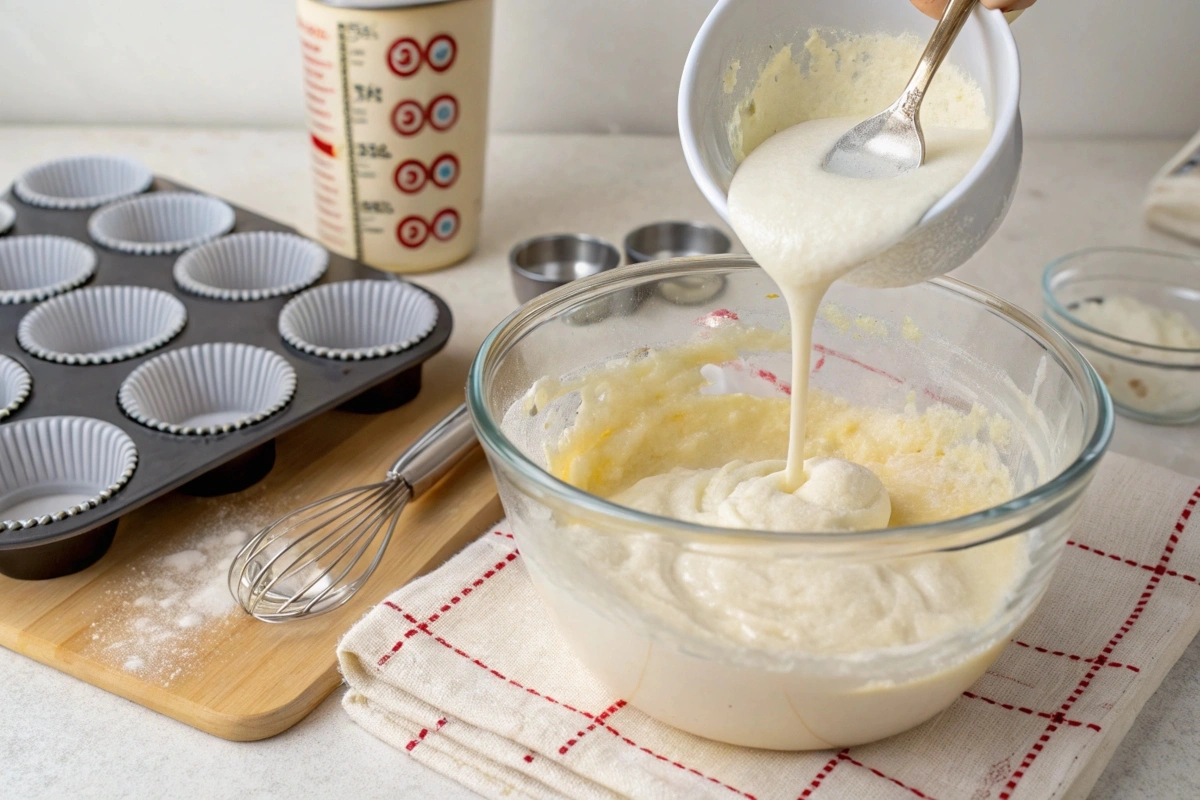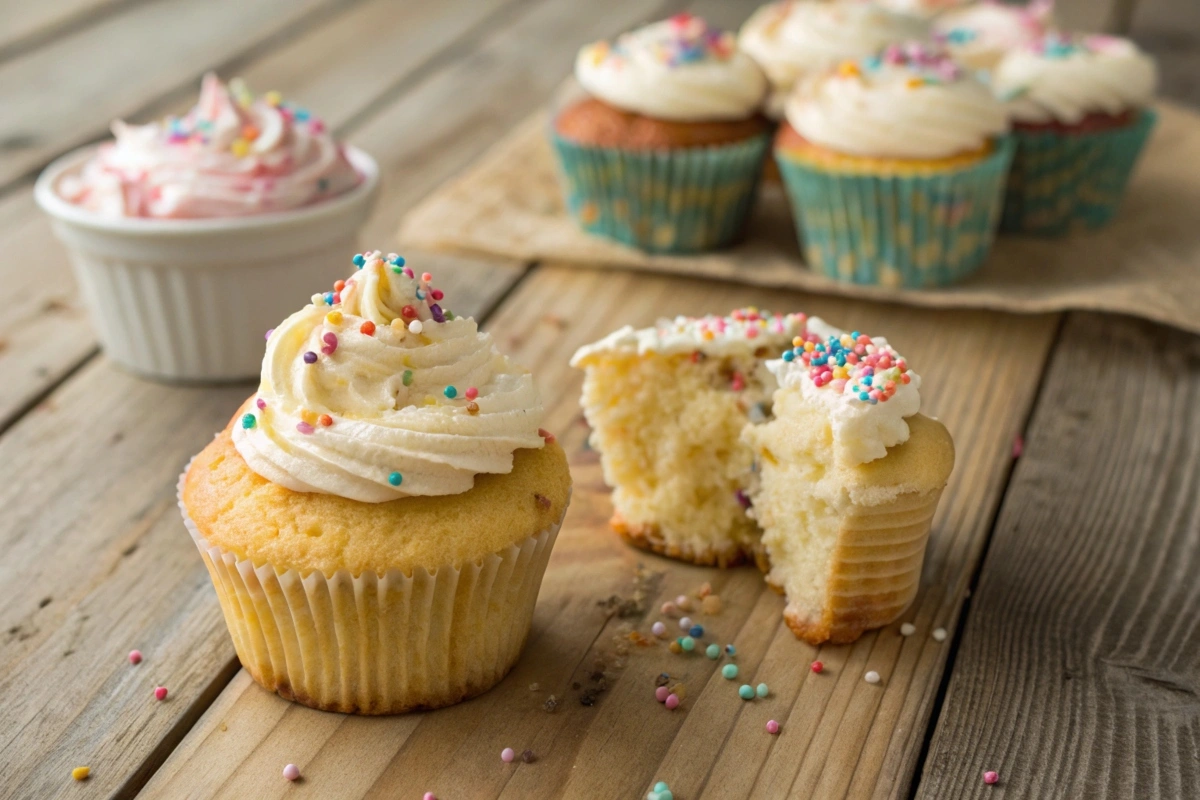Introduction
Cupcakes, those delightful handheld cakes, have become a universal symbol of celebration and comfort. But have you ever bitten into a cupcake that looked amazing but felt dry and crumbly? Ugh, such a letdown! If you’re here, you’re probably wondering, “What is the secret to moist cupcakes?” This guide uncovers proven tips, techniques, and ingredient swaps that guarantee irresistibly moist and fluffy cupcakes every time. From understanding essential baking science to expert-approved recipes, this article has you covered.
Understanding the Basics of What is the Secret to Moist Cupcakes?
The Role of Moisture in Cupcakes
Moisture is the heart of a cupcake’s texture, flavor, and overall appeal. A dry cupcake can ruin the experience, no matter how delicious it looks. So why is moisture so crucial? It binds the ingredients, creating a tender crumb while enhancing the richness of flavors.
Dryness often stems from overbaking, under-mixing, or skimping on wet ingredients. These issues disrupt the balance between liquids and solids, resulting in a crumbly, disappointing texture. Recognizing these culprits is the first step toward avoiding them.
Key Ingredients That Contribute to Moisture
Certain ingredients are true game-changers when it comes to making your cupcakes moist. Butter, for instance, adds flavor, but did you know vegetable oil often yields a moister texture? Oils, like canola or coconut, keep the cake tender for days.
Dairy products such as sour cream, buttermilk, and full-fat yogurt play another crucial role. They not only provide moisture but also enhance the cupcake’s tangy, rich taste. Adding fruit purees, like applesauce or mashed bananas, can also work wonders. These natural moistening agents improve texture while subtly boosting the flavor.
To summarize, balance is key. Combining the right ingredients in the correct proportions ensures your cupcakes stay moist, soft, and simply irresistible.
Secrets from Baking Experts
Selecting the Right Ingredients
What’s the golden rule for moist cupcakes? It starts with choosing the best ingredients. Baking is like chemistry; every component matters. Experts agree that fresh, high-quality ingredients make all the difference. Flour, for example, should be unbleached and fresh, as old or bleached flour can dry out the batter. Similarly, use real vanilla extract instead of imitation for a richer flavor.
The type of sugar you use also plays a significant role. Granulated sugar is the go-to, but incorporating brown sugar can add extra moisture due to its molasses content. Lastly, don’t forget the fats, unsalted butter and oils like canola or olive oil add richness and keep your cupcakes tender.
The Science of Combining Ingredients
Here’s where the magic happens, how you mix your ingredients can make or break your cupcakes. Ever wondered, “What is the secret to moist cupcakes?” Well, one trick is creaming the butter and sugar properly. This creates air pockets, which help the batter rise, leading to a soft texture.
Equally important is not overmixing once the dry and wet ingredients are combined. Overmixing activates the gluten in the flour, resulting in dense, dry cupcakes. Aim for a smooth but slightly lumpy batter. Remember, a light hand is your best friend when baking these treats.
Techniques to Enhance Moisture
Incorporating Moistening Additives
For truly moist cupcakes, sometimes the batter needs a little extra help. Additives like sour cream, yogurt, and buttermilk are popular because they introduce acidity, which tenderizes the flour. Plus, they lock in moisture without making the cupcakes greasy.
Simple syrup is another secret weapon. Lightly brushing this sugar-water mixture over the tops of baked cupcakes helps retain moisture. And don’t overlook fruit purees mashed bananas or applesauce can keep cupcakes moist and flavorful, while also being a healthier alternative to fats.

Proper Baking and Cooling Practices
Baking cupcakes is part science and part art. Getting the oven temperature just right is critical. A too-hot oven can dry out the edges before the center bakes. Always preheat your oven and use an oven thermometer for accuracy.
Once your cupcakes are baked, cooling them correctly is just as vital. Let them sit in the pan for 5-10 minutes, then transfer to a wire rack. This prevents overcooking from residual heat in the pan. Covering cupcakes loosely with a clean towel while they cool can also help keep them soft.
Recipes for Perfectly Moist Cupcakes
Classic Vanilla Cupcakes
Vanilla cupcakes are a timeless favorite, and tweaking the recipe slightly can ensure they’re always moist and delicious. Start by replacing half the butter with vegetable oil. This subtle change boosts the moisture level without compromising flavor. Using full-fat yogurt instead of milk is another trick to keep these cupcakes tender.
Here’s a quick recipe:
- Ingredients:
- 1 cup of flour
- 1/2 cup of butter (softened)
- 1/4 cup of vegetable oil
- 2 large eggs
- 1/2 cup of full-fat yogurt
- 1 tsp of real vanilla extract
- Instructions:
- Preheat the oven to 350°F and line your cupcake tray.
- Cream the butter, oil, and sugar until fluffy.
- Add eggs and yogurt, then mix in vanilla.
- Fold in the flour gently.
- Bake for 18–20 minutes.
For more delicious recipes, check out our article on secrets to moist homemade bread.
Moist Chocolate Cupcakes
Chocolate lovers rejoice! Chocolate cupcakes are naturally rich, but incorporating a few tricks makes them moist to perfection. Adding coffee to the batter enhances the cocoa flavor while helping retain moisture. Using buttermilk instead of regular milk is another game-changer.
Ingredients like brown sugar and a splash of oil create a tender crumb, making every bite a treat. For best results, avoid overbaking, as even a few extra minutes can lead to dryness.
FAQs About Moist Cupcakes
Why are my cupcakes dry even with the right ingredients?
Even when using the right ingredients, overbaking or incorrect measurements can lead to dryness. Always double-check your oven’s temperature and measure your ingredients precisely.
What can I do to salvage dry cupcakes?
Got dry cupcakes? Don’t worry! Brushing them with simple syrup or a flavored glaze can help add moisture back into the cake. This quick fix works wonders.
How does weather impact cupcake moisture?
Humidity can affect baking outcomes. In dry climates, adding a bit more liquid or using moisture-retaining ingredients like yogurt can help. Conversely, in humid environments, reducing baking time slightly prevents over-drying.
Creative Variations for Moist Cupcakes
Infusing Unique Flavors into Moist Cupcakes
Once you’ve mastered the basics of what is the secret to moist cupcakes, it’s time to get creative. Adding unique flavors can elevate your cupcakes to the next level. For instance, infuse the batter with citrus zest, like lemon or orange, for a tangy burst. Another idea? Incorporate spices such as cinnamon, nutmeg, or cardamom for a warm, comforting twist.
For adventurous bakers, using flavored syrups like lavender or rose can add an elegant touch. Don’t forget to match these flavors with fillings or frostings that complement them. For example, a vanilla cupcake with a raspberry filling and lavender frosting can leave a lasting impression.
Experimenting with Different Textures
Texture plays a big role in the cupcake experience. To add a delightful crunch to your moist cupcakes, consider mixing in chopped nuts, chocolate chips, or shredded coconut. Crushed cookies or caramel bits can also add surprises in every bite.
For fillings, try adding fruit jams, custards, or even ganache to the center of your cupcakes. These additions not only enhance the flavor profile but also contribute to keeping the cupcakes moist longer. Experimentation is key, so let your creativity flow!
Common Mistakes to Avoid for Moist Cupcakes
Overmixing the Batter
One of the most common baking pitfalls is overmixing. While it might seem tempting to mix until perfectly smooth, overmixing activates too much gluten, resulting in dense and dry cupcakes. Instead, stop mixing as soon as the ingredients are just combined. A few lumps are perfectly fine.
Ignoring Baking Times and Temperatures
Baking times and temperatures are not suggestions, they’re rules. Even a minute too long in the oven can turn your cupcakes dry. Use an oven thermometer to ensure accuracy and always set a timer. It’s better to check your cupcakes a minute early than risk overbaking them.
Skipping Ingredient Substitutions Thoughtfully
While substitutions can be fun, they must be done thoughtfully. For example, swapping oil for butter may make your cupcakes moister, but too much oil can make them greasy. Stick to tried-and-tested adjustments and avoid overcomplicating the recipe.
Seasonal Twists for Moist Cupcakes
Incorporating Seasonal Ingredients
Seasonal produce can transform ordinary cupcakes into extraordinary treats. In summer, fresh berries like strawberries or blueberries can be folded into the batter, adding bursts of juicy flavor and moisture. Similarly, fall brings opportunities to use pumpkin puree or grated carrots, both of which naturally enhance moisture while adding a rich, earthy taste.
Winter is perfect for warm, spiced cupcakes infused with flavors like ginger, nutmeg, and cinnamon. Try adding applesauce or cranberry compote for a moist, seasonal twist. Meanwhile, spring offers the chance to include delicate flavors like rhubarb or lemon curd for light, refreshing cupcakes.
Pairing Frostings with Seasonal Variations
Choosing the right frosting to complement your cupcakes is just as important as the batter itself. For moist summer cupcakes, a whipped cream frosting pairs beautifully, while cream cheese frosting works well with pumpkin or carrot cupcakes in the fall.
For a wintery touch, use ganache or spiced buttercream, and in spring, a zesty lemon or berry frosting can elevate your cupcakes. These thoughtful pairings not only balance the flavors but also make your cupcakes look as good as they taste.
Troubleshooting Moist Cupcakes
Why Are My Cupcakes Sinking?
If your cupcakes sink in the middle, it could be due to overmixing or opening the oven door too soon. Sinking can also occur if the batter is too thin, as it doesn’t have enough structure to rise properly. To avoid this, measure your ingredients carefully and resist the urge to peek while baking.
What Should I Do if My Cupcakes Are Overbaked?
Overbaked cupcakes can be rescued! Brush them with simple syrup or glaze while they’re still warm to reintroduce moisture. If they’re already cool, consider using a flavorful filling to cover up the dryness. Another trick? Warm them slightly before serving to soften the texture.
Is There a Quick Fix for Batter Consistency?
If your batter seems too thick, adding a splash of milk, buttermilk, or water can help achieve the right consistency. If it’s too thin, fold in a tablespoon of flour at a time until it thickens. These adjustments ensure that your cupcakes bake evenly and retain their moisture.

